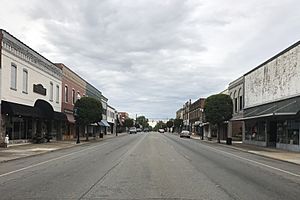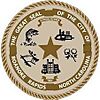Roanoke Rapids, North Carolina facts for kids
Quick facts for kids
Roanoke Rapids, North Carolina
|
||
|---|---|---|

Roanoke Avenue
|
||
|
||

Location of Roanoke Rapids, North Carolina
|
||
| Country | United States | |
| State | North Carolina | |
| County | Halifax | |
| Area | ||
| • Total | 9.95 sq mi (25.77 km2) | |
| • Land | 9.91 sq mi (25.67 km2) | |
| • Water | 0.04 sq mi (0.09 km2) | |
| Elevation | 138 ft (42 m) | |
| Population
(2020)
|
||
| • Total | 15,229 | |
| • Density | 1,536.27/sq mi (593.16/km2) | |
| Time zone | UTC−5 (Eastern (EST)) | |
| • Summer (DST) | UTC−4 (EDT) | |
| ZIP code |
27870
|
|
| Area code(s) | 252 | |
| FIPS code | 37-56900 | |
| GNIS feature ID | 2404628 | |
Roanoke Rapids is a city in Halifax County, North Carolina, in the United States. In 2020, about 15,229 people lived there. It is the biggest community in Halifax County. Roanoke Rapids is also an important city in a larger area called the Rocky Mount-Wilson-Roanoke Rapids Combined Statistical Area.
Contents
Exploring Roanoke Rapids Geography
Roanoke Rapids is in the northern part of Halifax County. To the north, it shares a border with Northampton County. This county line follows the Roanoke River.
The city covers about 25.9 square kilometers (9.95 square miles). Most of this area is land. Only a small part, about 0.1 square kilometers (0.04 square miles), is water.
Where the River Meets the Land
The city is located at the eastern edge of the North Carolina Piedmont. This is where the Roanoke River crosses the "fall line." The fall line is a special place where higher land meets a flat coastal area.
At the fall line, rivers often have rapids or waterfalls. This means riverboats usually cannot travel further inland. Because of this, towns often grew up here. They needed a port and water power.
The Roanoke River's rapids were key to Roanoke Rapids' growth. Businessmen like Sam Patterson used the river's power for their mills. Many cities along the eastern U.S. coast grew at these fall line spots.
Roanoke Rapids Climate
| Climate data for ROANOKE RAPIDS, NC, 1991-2020 normals | |||||||||||||
|---|---|---|---|---|---|---|---|---|---|---|---|---|---|
| Month | Jan | Feb | Mar | Apr | May | Jun | Jul | Aug | Sep | Oct | Nov | Dec | Year |
| Mean daily maximum °F (°C) | 49.5 (9.7) |
52.5 (11.4) |
59.8 (15.4) |
70.1 (21.2) |
77.8 (25.4) |
85.3 (29.6) |
89.4 (31.9) |
87.5 (30.8) |
81.7 (27.6) |
71.4 (21.9) |
61.1 (16.2) |
52.7 (11.5) |
69.9 (21.1) |
| Daily mean °F (°C) | 39.8 (4.3) |
42.1 (5.6) |
48.6 (9.2) |
58.2 (14.6) |
67.2 (19.6) |
75.3 (24.1) |
79.6 (26.4) |
77.7 (25.4) |
71.7 (22.1) |
60.8 (16.0) |
50.4 (10.2) |
43.3 (6.3) |
59.5 (15.3) |
| Mean daily minimum °F (°C) | 30.0 (−1.1) |
31.7 (−0.2) |
37.4 (3.0) |
46.3 (7.9) |
56.6 (13.7) |
65.4 (18.6) |
69.7 (20.9) |
67.9 (19.9) |
61.8 (16.6) |
50.2 (10.1) |
39.8 (4.3) |
33.8 (1.0) |
49.2 (9.6) |
| Average precipitation inches (mm) | 3.66 (93) |
2.93 (74) |
4.32 (110) |
3.60 (91) |
3.43 (87) |
5.05 (128) |
5.37 (136) |
5.23 (133) |
5.49 (139) |
3.59 (91) |
3.32 (84) |
3.50 (89) |
49.49 (1,257) |
| Average precipitation days (≥ 0.01 in) | 10.4 | 9.1 | 10.3 | 9.3 | 10.0 | 10.1 | 10.3 | 9.4 | 8.8 | 7.1 | 8.0 | 9.8 | 112.6 |
| Source: NOAA | |||||||||||||
Roanoke Rapids has a mild climate. Summers are warm and humid. Winters are generally cool. The city gets a good amount of rain throughout the year.
Population of Roanoke Rapids
| Historical population | |||
|---|---|---|---|
| Census | Pop. | %± | |
| 1900 | 1,009 | — | |
| 1910 | 1,670 | 65.5% | |
| 1920 | 3,369 | 101.7% | |
| 1930 | 3,403 | 1.0% | |
| 1940 | 8,545 | 151.1% | |
| 1950 | 8,156 | −4.6% | |
| 1960 | 13,320 | 63.3% | |
| 1970 | 13,508 | 1.4% | |
| 1980 | 14,702 | 8.8% | |
| 1990 | 15,722 | 6.9% | |
| 2000 | 16,957 | 7.9% | |
| 2010 | 15,754 | −7.1% | |
| 2020 | 15,229 | −3.3% | |
| U.S. Decennial Census | |||
The population of Roanoke Rapids has changed over the years. It grew a lot in the mid-1900s. In recent years, the number of people living in the city has stayed fairly steady.
2020 Census Data
In 2020, the census counted 15,229 people living in Roanoke Rapids. There were 6,051 households and 3,761 families.
Most residents were White (about 56%). A large number were also Black or African American (about 34.5%). Other groups included Asian, Native American, and people of Hispanic or Latino background.
2010 Census Data
In 2010, the city had 15,754 people. There were 6,437 households. About 30.9% of households had children under 18.
The average household had 2.42 people. The average family had 3.01 people. The median age in the city was 37.9 years.
Industry and Jobs
Roanoke Rapids started as a "mill town." This means it had many textile mills where fabric was made. A famous labor activist, Crystal Lee Sutton, worked in a mill here. Her story inspired the movie Norma Rae.
Today, all the textile mills have closed. This caused nearly 3,000 people to lose their jobs. Now, Roanoke Rapids is home to a WestRock paper manufacturing facility.
Fun Things to Do and See
Roanoke Rapids has many interesting historical places. You can learn about the past and explore.
Historic Buildings and Sites
The original Roanoke Rapids High School building opened in 1921. It looks like a castle with its unique design. A famous architect named Hobart Upjohn designed it.
Next to the high school is another castle-like building. This used to be a National Guard Armory. The high school and the Roanoke Canal are listed on the National Register of Historic Places.
Roanoke Canal Museum and Trail
The Roanoke Canal Museum and Trail is one of the city's oldest historical sites. The museum is in an old canal lock building from 1823. It shows how important the canal system was for trade.
You can learn about the people who wanted the Roanoke River to be used for shipping goods. The trail is over seven miles long. It runs next to the museum and the Roanoke River. It's a great place for a walk or bike ride.
Carolina Crossroads Entertainment District
Roanoke Rapids once planned a big entertainment area called Carolina Crossroads. It was supposed to have a theater, an outdoor stage, hotels, restaurants, and even an aquarium.
The Randy Parton Theater was meant to be the main attraction. However, the city's plans with Randy Parton ended in 2006. The city renamed it the Roanoke Rapids Theater. This project became a big topic of discussion due to the city's money involved. The city finally sold the theater in 2018.
Famous People from Roanoke Rapids
Many talented people have come from Roanoke Rapids, including:
- James Anderson, a former NFL linebacker
- Ricky Kej, a musician who has won three Grammy® Awards
- Brian Barnes, a former MLB baseball pitcher
- Chris Daughtry, a singer and actor
- George Grizzard, an actor
- Nazair Jones, a former NFL defensive tackle
- Kareem Martin, an NFL defensive end
- Crystal Lee Sutton, a labor activist
See also
 In Spanish: Roanoke Rapids (Carolina del Norte) para niños
In Spanish: Roanoke Rapids (Carolina del Norte) para niños


